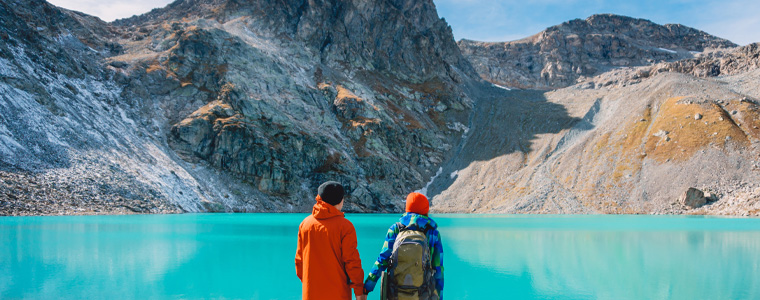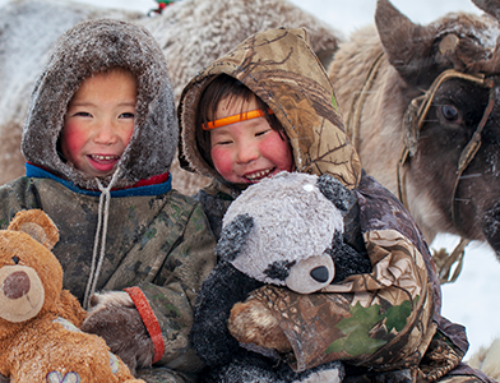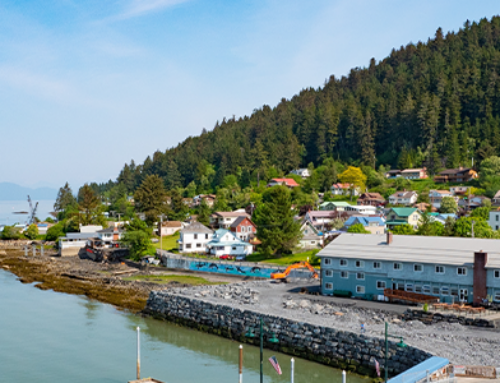You made it! You’ve successfully moved to Alaska, and you’re getting yourself settled into your home in the Last Frontier. Now it’s time to stock up so you’re prepared for anything Alaska might throw at you.
Below, you’ll find our list of the 13 things every Alaska resident should own. Whether you buy these items before you move—or make your purchases after you arrive—having these items on hand will ensure you’re ready for every kind of Alaskan adventure.
Item #1: Bear Spray
You’ll find bears almost everywhere in Alaska—especially brown bears, also known as grizzly bears.
(Side note: If you’ve never lived in an area with bears before, these guidelines from the Alaska Department of Fish & Game are a must-read.)
In addition to stocking up on your bear knowledge, it’s also a good idea to stock up on bear spray—just in case you’re charged by a bear. These canisters deploy red pepper oil that causes significant irritation in a bear’s eyes, mouth, throat, ears, and lungs. This will hopefully stop the bear’s charge and give you the chance to get away.
There are a number of different kinds of bear spray out there. Make sure you understand exactly how to deploy the canister you purchase. If a bear does charge you, there’s no time for learning. There’s only enough time to react.
Item #2: Layers
You might think the toughest part about being outdoors in Alaska would be staying warm. However, the real challenge is regulating your body temperature throughout the day.
If you’re doing any kind of vigorous activity—hiking, snowshoeing, cross-country skiing, etc.—your body temperature will rise. If you can’t peel off a layer or two, you’ll start to sweat. Hopefully, you’re wearing fabrics that will wick moisture away from your body. (More on that in a moment!) However, as soon as you start to really sweat, that’s when you run the risk of getting wet—and cold.
When you dress for the outdoors in Alaska, think in layers you can remove. That way, if the sun starts shining—or you work yourself into a sweat—you can adjust your outer layers to adapt. Here’s how that might look:
- Start with a base layer that will wick moisture away from your skin. Merino wool, capilene, and polypropylene thermal garments will all work. In cool weather, you’ll want a piece for both your top and your bottom.
- Layer a long-sleeved shirt on top. A button-down shirt will give you more flexibility.
- Put a fleece on next for some extra insulation.
- Top it all off with some kind of waterproof/weatherproof shell to protect you from the elements.
This philosophy will keep you comfortable in all kinds of Alaska weather, especially unpredictable conditions.
Now, there’s one other thing that can make you really cold in Alaska, and that’s getting wet from precipitation. Let’s talk about that next.
Item #3: Rain Gear
There’s nothing more important than keeping yourself dry when you’re exploring Alaska—or even just running errands. Make sure that you’ve got at least one piece of waterproof outerwear.
Even in mild weather, getting soaked can be a miserable experience, so it’s worth investing in a quality jacket. Consider buying one marked “waterproof/breathable,” which will offer a high level of water protection while keeping you from sweating up a storm. If you’re going to spend significant time outdoors, you might want to get a pair of rain pants, too.
You’ll find plenty of people in Carhartt jackets in Alaska. Helly Hansen and Grundéns are also popular brands in the state.
By the way, you’ll find plenty of outdoor gear stores in Alaska. If you haven’t bought rain gear before making the move, head on into your local store in Alaska. Give them an idea of what kind of activities you like to do, and they’ll match you up with the gear that’s right for you.
Item #4: The Right Foot Gear
In our final entry in the “making sure you’re not miserable in Alaska” files, let’s talk about footwear. When your feet are unhappy, it’s hard to be happy, period.
Here’s the great news: Alaska residents are very practical when it comes to footwear. In other words, very few people sacrifice comfort for fashion in the 49th state—and neither should you.
Here’s what you’ll need:
- Ditch your cotton socks. Cotton absorbs moisture and holds it next to your skin, which will make your feet clammy and cold. This can also lead to blisters. Instead, like your base layer, choose either merino wool or a synthetic material like CoolMax®.
- Get a pair of waterproof rain boots. XTRATUF boots are practically the gold standard in Alaska. Mucks and Bogs are also popular brands. Either way, waterproof rain boots are critical for navigating wet conditions—and mud.
- Get a good pair of hiking boots. If you’re going to be putting miles on your feet in the winter months, you might also want to invest in a pair of boots with a more flexible upper for navigating trails. Sorel, Oboz, and Columbia all make models that will keep you hiking for hours in comfort.
Item #5: A Sleep Mask
As you know, Alaska is the Land of the Midnight Sun. That means plenty of nights when you’ll need to sleep while the sun is still up. Many people swear by blackout curtains, and you may find those work well for you.
However, the simplest solution is a good sleep mask. The key is finding one that fits your face well—and works for the sleeping position you favor most.
Items #6 and 7: Snow Tires & Chains
If you haven’t had much experience driving in the snow, Alaska will offer you a quick education. At a minimum, you’ll need a set of snow tires/winter tires.
Winter tires come in two types:
- Studless winter tires. In contrast to all-weather tires, studless winter tires feature different tread patterns designed to offer greater traction in snowy and icy conditions. Additionally, they’re made with rubber designed to stay flexible at lower temperatures for increased grip.
- Studded winter tires. Just as it sounds, these have metal studs embedded to offer more grip on ice. They also offer different tread patterns and specialized rubber for snowy and icy conditions.
In all likelihood, you’ll probably want studded tires, especially if you’re driving a two-wheel drive car.
The other thing you’ll want to invest in is a set of chains. These give your tires extra traction when studded tires just won’t cut it. It’s always good to have a set in your car, just in case.
Finally, you might also consider getting a set of ice cleats for your shoes. All it takes is one bad slip to take you out of commission. You’ll find these in most outdoor stores in Alaska. Yaktrax are a popular brand, as are Due North Ice Grips.
Do I Need a Four-Wheel Drive Vehicle in Alaska?
If you’re living in and around Anchorage, plenty of people get by with two-wheel drive cars, as long as they’re front-wheel drive. However, if you’re consistently navigating steep driveways or hills—or you’re living outside the city—you might find a four-wheel drive vehicle easier to maneuver.
If you plan on taking your car on any winter adventures, upgrade to four-wheel drive, and get yourself a set of studded tires and chains—plus the emergency kit we’ll mention next.
Item #8: A Car Emergency Kit
Murphy’s Law pretty much guarantees that when you break down in Alaska, it’s going to be in the middle of nowhere. It’s not uncommon to find yourself a hundred miles from the nearest mechanic or tow truck.
To prepare for such an eventuality, make sure you have, at minimum:
- A flashlight with working batteries
- An ice scraper
- A shovel to help clear your car if it gets stuck in snow or mud
- A first aid kit
- Warm clothing, including blankets, an extra hat, and an extra set of gloves
- Flares to warn incoming drivers of a disabled car
- A small bag of kitty litter to help you get traction on ice, snow, and even mud
Plus, you’ll want a small, but mighty set of tools that could get you back on the road, including:
- Jumper cables
- A tool kit with all the basics you’d need for minor repairs
- A solution for a punctured tire: either a can of fix-a-flat or a puncture and plug repair kit
- A roll of duct tape – After all, no Alaska resident should ever be too far from a roll of duct tape!
If you’re on a trip to a more remote area, you might also want to pack some provisions, like food and water, in case you get stuck for a significant amount of time.
Life doesn’t get more extreme than Alaska, so it always pays to be prepared.
Item #9: A Fishing License
What’s more Alaska than fishing for your dinner? Once you establish yourself as an Alaska resident—meaning that you’ve lived in Alaska for at least a year, with no plans to leave—you’ll be eligible for a personal use fishing license for just $20. That license will be your ticket to the freshest salmon available, as well as all the other fish you can catch in Alaska.
While you’re at it, why not add hunting and trapping to that license? It will cost you $85 total, but it will open your world to a number of other options in Alaska, including bison, caribou, elk, Dall sheep, moose, and more.
Item #10: Some Kind of Mosquito Solution
Especially in the summer, mosquitos can turn into a real pain in Alaska.
Long sleeves and pants can certainly help. However, mosquitos in Alaska are persistent enough that you may turn to bug spray. Those with DEET are certainly the most effective, although some people prefer to avoid this harsh chemical. Repellants with picaridin can also be effective. Some still swear by Avon’s Skin-So-Soft Bug Guard.
You can also find insect-repellant gear treated with permethrin, designed to keep bugs away. Check out ExOfficio, L.L. Bean, and Craghoppers, who all produce insect-repellant clothing. Protection lasts up to ~60-70 washes. Sawyer also manufactures a permethrin spray you can use to treat your own clothing. This protection lasts about six washings, according to the company.
Whatever you choose, you’ll want to be prepared for the summertime swarms, which can be overwhelming to new residents.
Item #11: A Multi-Tool or a Hunting Knife
You’ll find plenty of people in Alaska with a knife or a multi-tool at the ready. You might think they’re just for hunting or fishing, but you’d be surprised how often they come in handy in Alaska.
Everyone’s got their own personal preference, so we’ll offer you a couple of options to consider:
- A multi-tool, like a Leatherman – A Leatherman is a pure workhorse. In addition to a sharp blade, it can be a pair of pliers, a screwdriver, a wire-cutter and -stripper, a saw, a wrench, a hex bit drive, a box wrench, and more. A solid multi-tool can get you out of some pretty sticky situations, no question.
- A folding knife – Lighter than a multi-tool, and easy to stick in your pocket and carry with you. However, folding knives are a bit harder to clean and more prone to breakage.
- A fixed blade – Stronger, easier to clean, and quicker to access.
Ultimately, you’ll find plenty of Alaska residents with one of each. At a minimum, make sure you have at least one handy—just in case.
Items #12 and 13: Binoculars—and a Sense of Wonder & Awe
In Alaska, you’ll have more up-close wildlife adventures than most people will in their lifetimes. But sometimes the really cool stuff can only be spotted at a distance.
That’s why it’s always handy to have a good set of binoculars at the ready. Who knows what you might spot at a distance? An orca whale? A rare bird? A flock of Dall sheep?
Along with the binoculars, we recommend you hold on to your sense of wonder and awe. It’s easy to get immune to the incredible sights in Alaska that you’re exposed to on an almost-daily basis. However, if you can remember how unique this place is—and how lucky we are to enjoy it—you’ll find your life in Alaska that much more enriching.
Considering a Move to Alaska?
If you haven’t yet made the move to Alaska, we’d love to help you make a safe, easy, and affordable relocation. Just reach out to one of our experts for a complimentary quote. We also do moves within Alaska, as well as moves from Alaska to the lower 48. (Although we’d hate to see you go!) Our Anchorage-based team has done moves to and from locations all over the state, and we’d be happy to help you.
Tell us about your move!
 (907) 868-4756
(907) 868-4756


